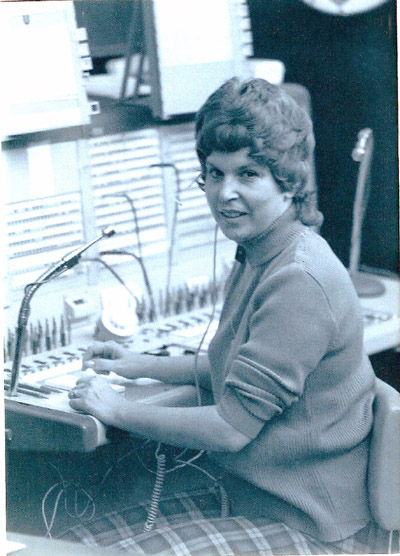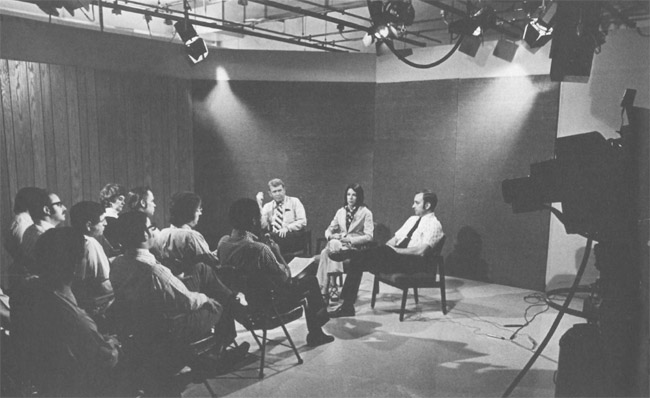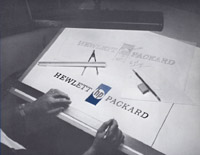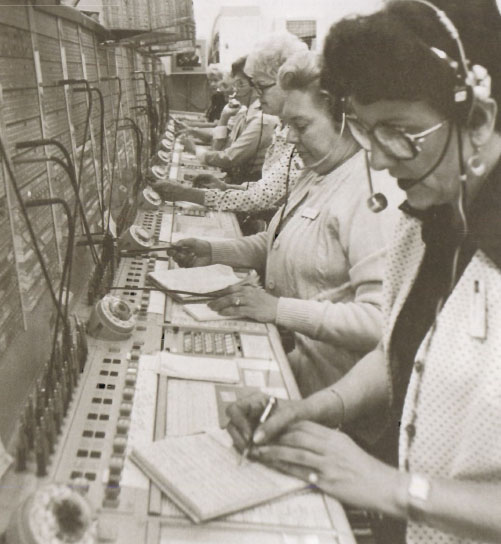HP Memories


 |
| Betty Haines – PBX/Lobby 8U – circa 1972 |
In 1972, I transferred to the Manufacturing Division to work in the switchboard/lobby and mail room in Building 8U at 395 Page Mill Road. The Redwood Building was located on this site. The Redwood Building was first building that HP owned. HP grew from The Garage, to The Cabinet Shop (a leased building behind Polly and Jakes antique shop), to The Redwood Building. Is it any wonder that the years I spent on this site hold a special place in my memory? Being involved with so many HP groups and functions that occupied this site in the 1970’s, watching them grow, shrink, spin-off and disappear, was an emotional roller-coaster. Many of the happiest and saddest times of my HP career occurred while working at this site.
When I moved to the site it was occupied by the company’s automotive shop and the metal fabrication shop, both of which were in Quonset huts at the back border of the site. The other buildings were empty and being renovated. In fact, company safety regulations stated that an employee could not work alone in a building, so HP had a guard sit in the lobby of 8U when I was on duty at the switchboard. This continued until renovations were completed and Wayne Mehl’s Components group moved down from Building 15.
After the Components group was settled at the site, Yas Shimoguchi moved his Plastic Molding shop down from the Stanford Plant. I worked with him to arrange to purchase and import Big Bertha from Germany. At the time, Big Bertha was one of the largest injection molding machines on the west coast of the USA and by far the largest machine that HP had acquired. This machine was so big that laborers had to remove the roof of Building 7, so that a gigantic helicopter could lower that machine into place.
The second year I was on this site, a young engineering student, named Mike Johnson, was hired as a summer intern. Nobody arranged desk space for Mike prior to his arrival; so, temporarily, he sat at a table in the hallway behind the switchboard and endured very unique telephone service arrangements. When he received a call, I connected it to the back-up switchboard position, rapped on (or yelled over) the partition behind the switchboard, Mike stood up and reached over the partition, I passed the headset over to him and he answered his call. In spite of this chaotic beginning, Mike chose to work for HP full time after he graduated and he and I developed a bond that has endured to this day.
I felt as though I lost a family member when Lew Cantwell, who had been site manager, relocated to HP Singapore to help set-up and manage the HP facility there.
One of the happiest and most exciting times for the site was the completion of Building 12, the new Metal Fabrication building. Carl Buchass and Art Turnbull were finally able to get that function out of the Quonset huts and into a modern state of the art facility. One of my prize possessions is a Bufano Quail that was cast in this new building.
Jim Ferrell, who was General Manager of the Manufacturing Division when Building 12 was constructed, was one of the most competent and dedicated managers that I was ever privileged to call “boss.” He was ethical, he walked the talk, he lived the HP Way. He loved practical jokes and possessed the rare ability to take a joke with grace and to laugh at himself.
San Francisco’s famous Benny Bufano Society of the Arts granted HP permission to produce metal castings of a Bufano sculpture titled The Quail. This was to be done in the new Metal Fabrication facility, Bldg 12. These castings were copyrighted and numbered (mine is #321, the same as Jim’s telephone extension number during the years he was my boss). Jim was so pleased with this honor that, after producing a Quail for each site employee, he arranged for a few extras to be cast. He planned to present one of these castings to Executive V.P. Bill Terry and another to V.P. Hal Edmonson at an upcoming Division Review meeting.
On the day of the presentation, Jim placed the sculptures on a wheeled cart outside meeting room door and draped them with a velvet cloth. While Jim was addressing the meeting, members of his staff (who shall remain nameless) slipped the Quails from under the cloth and replaced them with rubber chickens. Needless to say, when Jim wheeled in the cart, whipped off the cloth and saw the rubber chickens he was shocked. The room erupted in laughter and, when Jim recovered his composure, he laughed loudest of all. Of course, he threatened all of his employees with dire consequences for this act of rebellion; but we knew that they were hollow threats.
|
Curator Note This HPMemory.org website gets viewed by thousands, and often a reader will recall their own memories of some specific story. In this case, James Robinson, who was an electrician in the HP shops, and was familiar with all of the Manufacturing Division happenings, came upon a related incident about the Bufano Quail. His son had noticed an EBay offering of a gold-plated Bufano Quail for sale. Having read Betty's story, he notified us of the item, including a picture of the quail. When we notified Betty, she offered some additional information, which we have placed in the Other HP Writings section. (Click here) |
In 1976, my husband, Vern, and I celebrated the 10 year anniversary of our employment at Hewlett Packard. I attended the service awards lunch at the Manufacturing Division, where I was working at the time. However I did not receive my service award. General Manager, Jim Ferrell informed me that there had been a delivery problem and my award was not available. That is one of the very few times Jim lied. He had arranged for me to attend the Corporate Offices service awards lunch the next day and to have my award presented at the same time that my husband, Vern, received his award.
Bill Hewlett and Bob Boniface were hosting this lunch. Awards were being presented by year, in alphabetical order. Ironically, everyone receiving an award, up to this point had been female. This prompted Bill Hewlett to ask Bob Boniface, “Did we hire only women in 1966?” Bob said, “No, Bill.” Then he began a long tale about how Betty Haines came to be hired by the company. As Bob spoke, other attendees began looking at me with mystified expressions. The mystery was cleared up when Bob concluded, “Betty told me that the only way she would become a long term Hewlett Packard employee was if I found her a husband. So I arranged to hire Vern Haines in 1966.” Of course, Bob had done no such thing; but, it cracked up the crowd and was the perfect transition to the dual award presentation that he and Bill did for Vern and me.
By the late 1970’s, as more and more call processing functions were automated, the amount and variety of interactions between PBX operators and their internal HP customers was greatly reduced. I no longer found my job as rewarding or exciting as it had been in the past. So I began looking around for a career change.
When Carl Mahurin began recruiting me to set up and staff the lobby/switchboard area of Building 18, the new building into which he was moving Corporate Training and HPTV, I was immediately interested. This building and its function was going to be involved with key customer training on site, as well as a continuous stream of new Field Engineers coming through our Neophyte Seminars. When he offered to help me to phase into the video dubbing operation that was associated with HPTV, I jumped at the chance.
Once more, fate stepped on my career plans; it was déjà vu, all over again. Construction problems delayed the move into Building 18 and again, temporarily, I had no job. However, Carl took a page from Al Dossola’s play book, assigned me to sort and deliver mail in Building 9Z, where some of his staff was temporarily housed. 9Z was a rickety old building, on the east side of Bayshore Highway (101), between the Palo Alto Yacht Harbor and the city dump. HP used it as temporary over flow space. It was isolated from other HP sites in Palo Alto and the employees who were stuck there resented the isolation. Consequently, we developed a few sloppy work habits. One of those habits was for everyone to leave the site at lunch time and often, remain away for more than an hour.
One day a group of us came back to the site after a long lunch and found Mr. Packard waiting in the parking lot. This was the first time I saw the famous (or infamous) Packard temper in action. He was not gentlemanly or kind to his employees that day. On this occasion I would not have dared to call him Pappy or make any Hello Girl reference, he was all stone cold business. I just wanted to crawl into a hole and become invisible. He herded us into a conference room and informed us that he had received an embarrassing call from an old and highly valued customer asking for help with a video order. This customer had apologized to Mr. Packard for inconveniencing him, but explained that he urgently need help with a video order and had not been able to reach that department for well over an hour.
Mr. Packard wasn’t in the mood for any excuses or to listen to anything we had to say. Not only that, but he considered that it was important for him to take his personal time to drive from his office on the hill, down to the Yacht Harbor. He told us, in no uncertain terms, to correct this situation and never let anything like it occur again. He concluded by telling us that if we couldn’t or wouldn’t do as he asked, we were welcome to “leave and I will get some folks in here who will.”
Periodically, Corporate Training conducted Neophyte Seminars and invited groups of new HP Field Engineers, from all over the world, to Building 18 to participate in it. One of the high points of this training was one hour classroom course on “wine tasting,” taught by Fred Waldron, a serious wine aficionado. Then, after the class day was over, there was a barbeque, followed by wine tasting and a meet and greet with company executives. Mr. Hewlett and/or Mr. Packard sometimes attended these events, but, it was very common practice, for Norm Neely, Bob Boniface, Ed Van Bronkhorst, Jack Petrak, Frank Cavier, John Young, Emory Rogers, Bill Terry, Dave Kirby, Russ Berg, Bill Doolittle, etc. to serve the wine, man the grill, and chat with the neophytes and department employees.
Myrt Ebright and Fred Waldron worked very hard to arrange these events. Myrt was not above asking for divine intervention to ensure good weather. Many times he asked me to “pray that it doesn’t rain on the barbeque.” At one soggy barbeque (the third in a row that it had been moved inside because of rain), Chuck Ernst told attendees that he had overheard Myrt asking me pray that it wouldn’t rain. John Young, who was standing near Chuck, looked directly at me and said: “Then, that’s the problem and here’s an easy an easy solution. Betty, don’t pray.” From that time on, when the neophytes came to town the plea around Building 18 became: “Betty, don’t pray.”
 |
| Origin point of a video broadcast, Bldg 18 Courtesy of the Hewlett Packard Company |
We had two TV studios in Building 18; one produced black and white videos—remember, this was still the 1970’s—and the other produced color videos. Walt Robson, a large outgoing man with reputed ties to Hollywood and the film industry, managed HPTV and was able to entice some excellent talent into the studios. Early HP training videos include such stars as: Bill Onken (of “Get that Monkey off My Back” fame) Dave Golds (who later worked with Jim Henson on “The Muppets”) and Robin Williams (before he became “Mork”).
 |
| Packard: "Don't mess with the HP Logo!" |
One summer Peter Young, the teen-aged son of CEO John Young, volunteered to build sets for HPTV. Somehow he managed to get a screw driver imbedded deeply into his hand, paramedics were called and they transported him to the emergency room over at Stanford. I contacted John Young’s office, asked his secretary, Nancy Thoman, to let him know of Peter’s accident and that he was being taken to Stanford Hospital. My manager was not pleased to hear that I had done this. He felt that I used poor judgment and should not have “bothered” John. He changed his tune later that afternoon. On the way home from the emergency room, John and his wife brought Peter by Building 18 to see me. They wanted me to see that he was fine and to thank me for contacting John so quickly. They graciously credited me with speeding up the permission to treat process and making it possible for them to be with Peter while he was getting his hand stitched up.
Carl Mahurin’s health declined to the point where he was only able to work part time, unfortunately this rendered him unable to keep his promise to help me move into a video dubbing job.
I applied for and got a job as Telephone Service Order Coordinator. Harold Peterson supervised that area and trained me in the art of processing telephone service orders. He was a stickler for detail. Things were done to his specifications or he rejected them. Under his tutorage, I learned to read floor plans, mark them for use by telephone company installers and place stickers on the floor in the exact location the equipment was to be installed. This was an unglamorous, sometimes unpleasant, part of the job; but, Harold deemed it necessary. Placing the sticker in the general area of installation was unacceptable in Harold’s eyes. Therefore, if reaching the exact location required squeezing into narrow telephone closets, handling dusty cables, and crawling under desks, that is what he expected me to do.
About ninety percent of the telephone service orders required the updating of Key System Worksheets. For this part of my training Harold sent me to a vendor-sponsored workshop, where I discovered that I had a real talent for this. I loved recording multiple changes on the most complex worksheets.
While I was working as a telephone service coordinator, Hewlett Packard converted its Palo Alto sites to a new telephone system—a CO Centrex System. A major portion of the call processing equipment for this type of system was located in the phone company’s Central Office and it provided PBX-like telephone service at greatly reduced equipment cost. In addition to reducing equipment costs, the Centrex system allowed outside calls to be dialed directly to extension telephones. Converting to the Centerx system slightly altered the way telephone service orders were processed and some additional training was required. However, rumors of massive changes in this area proved false; my job was not greatly impacted.
The HP switchboard operators were not so lucky; some of the operator jobs went away and new jobs had to be found for them. Because some Palo Alto locations had a switchboard/lobby set up, in which the operator also served as receptionist, operators in these buildings continued to work as receptionists and were assigned other clerical duties to make up for the loss of switchboard activity. For the ones whose jobs disappeared, their unsung hero was Bill Taylor. It was his duty to help displaced operators find other jobs within HP. He put his heart and soul into this project. I recall one occasion when he actually signed out a company car and drove an operator to an interview at a South Bay site of HP. It was just another example of the extreme concern that some HP managers would show for their employees.
 |
| Corporate telephone system to retire . . . ( PBX/Lobby 1U – circa 1977 ) from MEASURE Magazine, September 1977 Courtesy of the Hewlett Packard Company |
In 1981, Corporate Telecom implemented one of the first private nationwide, voice telecommunication networks that Hewlett Packard owned. It was called TELNET. I was surprised and delighted when I was asked to join Bill Taylor, Gene Doucette, Gary Burgess and Mickey McNamara on this project. My role was to help with the publicity and to conduct TELNET training sessions for employees in the Bay Area.
For the duration of the project, my day-to-day activities were assigned and evaluated by Bill Taylor and Gary Burgess. They encouraged me to work independently and develop my own training materials and schedules. I found their management style refreshing. Basically, they said, “Ask for help when you need it, otherwise, we trust your judgment on how to get the job done.” Up to this point, I was accustomed to being bound to a switchboard by a 4 foot cord or processing telephone service orders under the watchful eye of Harold Peterson--who felt that HP made a mistake when it removed employee time clocks.
I attended as many TELNET planning meetings as I could; learned to explain the system upside down and backward. I created a nifty slide show and mastered the art of clicking the Kodak slide projector controls so that the slide matched what I was saying. I even developed a knack for answering the same set of questions over-and-over without missing a beat or appearing bored.
The last group scheduled to receive TELNET training was upper managers; by this time I had conducted numerous training sessions and was comfortable with my routine. Maybe, I was too comfortable; perhaps I was just a bit cocky. As the VP’s, their Executive Assistants, and about three dozen department heads walked into the Building 20 auditorium and took their seats, I experienced a few butterflies; but, I had no premonition, that I was about to be struck mute. I was introduced, stepped confidently up to the microphone, looked out over the audience.
Suddenly it hit me, these were the people who made this company successful and held its future in their hands. I opened my mouth and nothing – absolutely nothing - came out. I guess panic registered on my face; Bob Boniface raised his hand and said, “I’m over here, Betty, just talk to me.” That kindness freed my vocal cords, saved the day and resulted in one of the most effective and relaxed training sessions that I ever conducted. The prissiest Executive Assistant to attend that session (and who shall remain unnamed) complimented me on the clarity of my presentation as she left the auditorium.
From the beginning of my career, I had been encouraged to move into management. Many of my managers and peers considered managing to be a natural career path for me. Very few understood my reluctance to pursue this path; but I felt more comfortable as an independent contributor. However, I had greatly enjoyed the independence that I experienced while working on the TELNET project and I found going back to work for Harold Peterson restrictive. I missed planning my own schedule, making my own decisions and being judged on results. Management began to look a little more attractive to me and I decided that it was time to try my hand at it.
I accepted the position of Administrative Services Manager at Computer Supplies Operation in Sunnyvale. Surprisingly, there was much that I enjoyed about managing. I enjoyed creating and conducting surveys that identified the actual needs of internal and external customers. I thrived on the challenge of adapting or implementing procedures to meet the identified needs. I found it rewarding to serve as advisor, counselor and occasional mother hen to my employees. I did not like wage reviews, ranking sessions, and putting an employee (who refused to do the job she for which she was hired) on probation. I quickly learned that managing people was a lot different than managing processes and procedures and that it was a game I didn’t want to play.
My short detour into management taught me a few valuable lessons: 1) I was not cut out to justify the value of anyone’s performance, other than my own, 2) I found employee ranking to be arbitrary and usually reflective of the orating and negotiating skills of the managers, not the skills of the employees who are being ranked, 3) My real passion and talent lay in the rapidly changing field of telecommunications technology. More than anything, I wanted to help determine how Hewlett Packard would use this technology to the company’s best advantage. Bottom line, I knew I would be much happier and more productive managing processes, procedures, and customer requests that managing people.